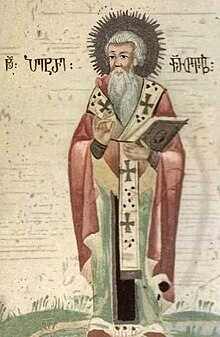Peter the Iberian
Peter the Iberian (* 411 in Georgia , † 491 in Palestine ), originally Nabarnugi (os) , was a Georgian prince, later a monk and bishop of Gaza-Maiuma.
Nabarnugios was a son of King Bosmarius of Kartli in eastern Georgia ( Iberia) . At the age of twelve he was taken hostage to the court of Emperor Theodosius II in Constantinople to ensure that Georgia would not ally itself with the Persian Empire. He belonged to the retinue of the Empress Eudokia, who gave him a good education. With the help of the eunuch Johannes, he fled the imperial court around 437; the two came to Jerusalem disguised as slaves. Melania the Younger took Nabarnugios and Johannes into the men's monastery she founded on the Mount of Olives. The prince received the monastery name Peter the Iberians from Abbot Gerontios. At the Tower of David , Peter set up a Georgian monastery with Xenodochion . When the Empress Eudokia came to Jerusalem and Peter wished to speak more often, he was faced with the question of whether he wanted to return to the life of a courtier. He thought it better to leave Jerusalem entirely and joined a community of monks in Gaza-Maiuma.
At the Council of Chalcedony he emerged as the spokesman for the Monophysites .
In 452 the people of Gaza-Maiuma urged the Jerusalem Patriarch Theodosios to consecrate Peter as bishop, which then happened. Seven years earlier, Peter had been ordained a priest in a similarly involuntary manner. At the beginning of 453 he got rid of the unpopular episcopal office when a revolt broke out. He then led an unsteady wandering life as a refugee, hid in Oxyrhynchos and from there developed a lively activity. In 475, at the request of the anti-Chalcedonian-minded population, he returned to Palestine and set up a monastery near Ascalon .
The resolute theological positioning of Peter the Iberian had repercussions on his country of birth. Under King Vakhtang I , an independent Georgian Catholicosate was established , for which Peter mediated an anti-Chalcedonian hierarchy through his contacts with the Patriarch of Antioch, Petrus Fullo .
Web links
- Ecumenical Lexicon of Saints: Peter the Iberian
literature
- Friedrich Heyer: 2000 years of church history in the Holy Land: martyrs, monks, church fathers, crusaders, patriarchs, excavators and pilgrims. Lit Verlag, Hamburg 2000.
- Cornelia Bernadette Horn: Asceticism and Christological Controversy in Fifth-Century Palestine. The Career of Peter the Iberian. Oxford Early Christian Studies. Oxford University Press, Oxford, England, 2006. ISBN 978-0-19-927753-7 .
- Cornelia Bernadette Horn and Robert R. Phenix Jr. (Eds.): John Rufus: The Lives of Peter the Iberian, Theodosius of Jerusalem, and the Monk Romanus. Edited and Translated with an Introduction and Notes by Cornelia B. Horn and Robert R. Phenix, Jr. Writings from the Greco-Roman World, 24. Society for Biblical Literature: Atlanta, GA, and Brill, Leiden, Boston, 2008. ISBN 978-1-58983-200-8 .
- Richard Raabe (ed.): Peter the Iberians. A character image of the church and moral history of the fifth century. Syriac translation of a Greek biography written around the year 500. Leipzig 1895 ( online )
- Gereon Siebigs: Emperor Leo I: The Eastern Roman Empire in the first three years of his reign (457 - 460 AD) . Walter de Gruyter, Berlin / New York 2010.
Individual evidence
- ↑ a b Gereon Siebigs: Emperor Leo I. S. 124 .
- ↑ a b Friedrich Heyer: 2000 years of church history . S. 49 .
- ^ Friedrich Heyer: 2000 years of church history . S. 87 .
- ^ Friedrich Heyer: 2000 years of church history . S. 91 .
- ^ Friedrich Heyer: 2000 years of church history . S. 101 .
| personal data | |
|---|---|
| SURNAME | Peter the Iberian |
| ALTERNATIVE NAMES | Nabarnugio |
| BRIEF DESCRIPTION | Georgian prince, later monk and bishop of Gaza-Maiuma |
| DATE OF BIRTH | 411 |
| PLACE OF BIRTH | Georgia |
| DATE OF DEATH | 491 |
| Place of death | Palestine |
